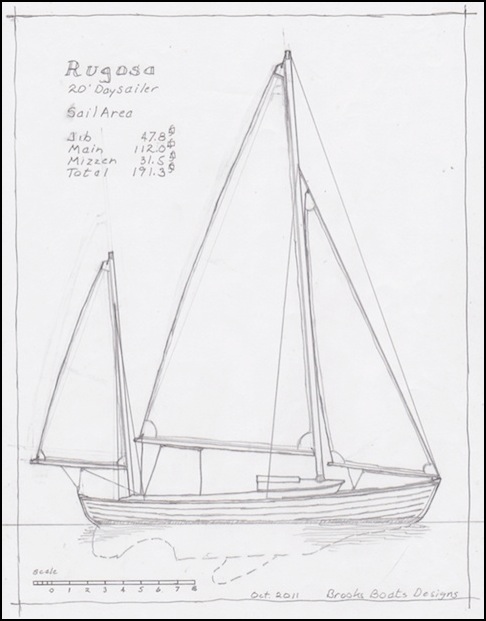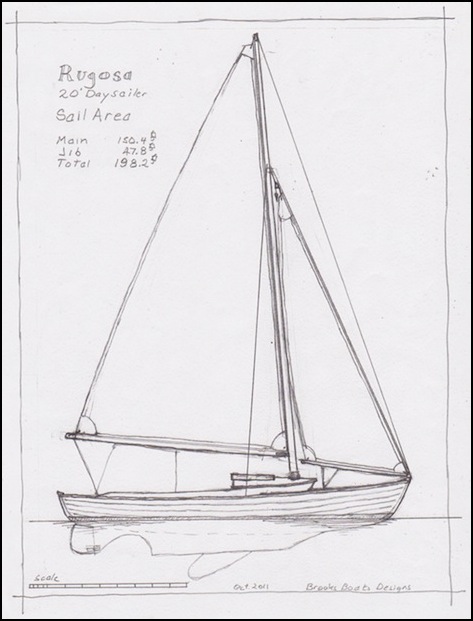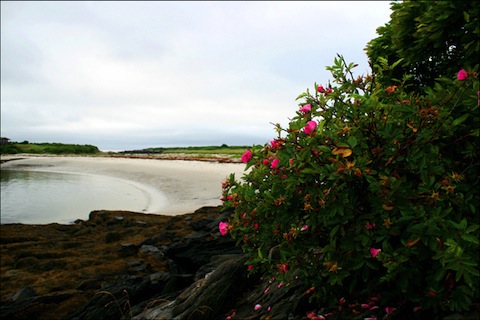introducing the. . .
Rugosa 20’ ketch
(FIRST SKETCHES)
DOWNLOAD PDF:
Rugosa ketch sailplan
DOWNLOAD PDF:
Rugosa sloop sailplan
Specifications
LOA 20’ (6.1 m)
LWL 18’-3” (5.56 m)
Beam 6’ (1.83 m)
Draft 2’ (.61 m)
Displacement 2,500 lbs. (1,134 kg)
SAIL AREA
Sloop 198 sq.ft. (18.39 sq.m)
Ketch 192 sq.ft (17.84 sq.m)
About the design process
Our boats are not designed on a computer. These first quick sketches capture the idea and soul of a new boat, then they are refined in preliminary drawings as the design discussion continues. The hull takes shape on a lines drawing and as John carves a half-model for the design, and many of her lines are taken from it. All the drawings for our plans are hand-drawn; John finds that drawing by hand allows him to bring the boat in his mind fully to life on paper. A builder of many years of experience, John puts many practical and buildable details in the plans.
______________________________________
The origins of Rugosa:
a little ketch inspired by L. Francis Herreshoff’s Rozinante
This newly sketched design came out of recent discussions that combined considerable affection for L. Francis Herreshoff’s Rozinante, the lovely and well-known 28’ canoe yawl, with the desire for a smaller cousin that would be easier to trailer and also sail (and moor) in enclosed, shallow inland waters when she wasn’t enjoying a free run in deep, open waters offshore. Rugosa draws almost two feet less than the Rozinante, a critical difference in places where waters thin out at low tide or close to shore.
Six or seven years ago Ben Fuller (director of Maine’s Penobscot Marine Museum and a skilled small boat sailor) wrote in Maine Boats, Homes, and Harbors magazine about the qualities he believed would be present in a good boat designed for cruise/camping from island to island along the Maine coast. In his article, he also issued a call for new designs.
I sent in proposal sketches for three designs that offered different approaches to the ideal. One of them was for a smaller version of the Rozinante.
In designing a sailer for the Maine Island Trail, I thought about the Maine’s strong tides and the breezy conditions we get on many afternoons. . .and also about places with skinny water: over mud, sand, and rocks. I also thought about a boat that, although it couldn't be pulled up on a beach, it could at least snuggle up to the beach for easy unloading and loading, then be pulled back out into deeper water with an outhaul to an anchor. Also, there is enough pressure on camp sites on many islands that being able to camp on the boat at times would be a good idea. I thought that a 20' version of Rozinante, with a shoal draft, would be perfect.
However, the magazine chose to publish another of my designs, so the drawings for my little Rozi—called Rugosa–have lanquished in a file. Rugosa is named for the salt spray rose, a hardy lovely capable flower that thrives along the shore in salt air.
Earlier this fall, I got to talking with a customer and others about different designs for daysailers that would be ideal for coastal exploring and perhaps a little camping. I pulled out the Rugosa sketches, updated them and drew two sail plans, a sloop and a ketch. The original had a 5' beam that I widened to 6', the same as our Somes Sound 12 1/2.
Rugosa weighs in at 2,500 lbs., a little less than half the weight of a typical Rozinante. She has a long fin keel, and a separate skeg in front of the rudder that will make her more manueverable while protecting the rudder. Also note in the sections that the lead keel has a reverse flare to the bottom that helps reduce leeway and gets the center of gravity lower. This keel shape will be a big help when the time comes to pull the centerboard up when venturing about in the shallows. Although this design gives the keel more surface area than some other alternatives, I think this is small compared to its advantages. This keel shape will also be easier to pattern or mold than more rounded designs, making it more efficient to make the lead keel.
Besides the fact that the original Rozinante has a ketch rig, there are several advantages to this rig. The sail plan is broken up into three sails instead of two so the center of effort is lower and offers better stability on a shoal draft boat. The mizzen is small so you won't have to fuss with it much. I’ll also make the boat balance under jib and mizzen so you can drop the main in a squall and still sail, or so you can motor up to the dock with the sail-assist of the jib and mizzen, the main having been dropped and tied with a couple of sail ties so the cockpit is clear for easier steering and handling lines as you work in close quarters.
The mizzen mast steps on the aft deck—so the tiller can swing freely underneath—and is held up with four shrouds. This is an arrangement that Doug Hylan worked out on a Rozinante that he built. I sailed on this boat when I worked for him—and this tiller arrangement functions very nicely and is a big improvement.
Both rigs have reasonably sized, easy-to-handle sails, and will sail (and look) great. The sloop rig is simpler and will likely sail to windward a little (a little) better. But, the ketch rig is our favorite!
The Rugosa’s cockpit is comfortably sized: not too large, not too small. Just right. Her cabin is big enough for her crew to get out of the weather or take a nap (especially fine if you have kid crew who need a restorative once in awhile.) There is room for a portapotty or other modestly sized seat of ease. Note that the hatch on Rugosa is not a sliding one, but a low profile design. Our thought is that the hatch could be raised to give enough head room for someone to sit upright on the throne; folding canvas sides attached to the hatch would provide a relaxing amount of privacy.
A boom tent or similar arrangement would make camp cruising comfortable and fun. We’ve also discussed giving Rugosa legs so she can be beached on the hard, for a bit of a swim off a beach, or exploring (and running, for the younger crew) on sand (or mud, what grand fun!) flats. Or a little clamming for dinner . . . .
Like the rose she is named for, Rugosa is elegantly simple, perfectly suited to life along the coast and easy to take care of.

"Your design has all the beauty and elegance of Rozinante, but a personality of its own. And I love the name Rugosa! I love Rosa rugosa, the beach rose (we had huge hedges of it in front of the beach house in Gloucester my parents owned when I was growing up). There's a subtle homage to Rozinante in the r's and s's, and a fitness to the lapstrake hull construction. There are many admirers of Rozinante out there, but few comparable boats that a home builder can aspire to. I think you have a best seller on your hands!”

We’d love to hear what you think!
Send us an email . . . .


